Enhancement of Gas Barrier Properties of Graphene Oxide/Poly (Lactic Acid) Films Using a Solvent-free Method
Abstract
:1. Introduction
2. Experimental
2.1. Materials
2.2. Preparation of GO-KH560
2.3. Film Preparation
2.4. Characterization and Measurement
2.5. Oxygen Permeation Analysis
3. Results and Discussion
3.1. Structure and Morphology Analysis of GO and KH560-GO Powder
3.2. XRD
3.3. DSC
3.4. Gas Barrier Properties of GO/PLA and KH560-GO/PLA Nanocomposite Films
3.5. Mechanical Properties
3.6. Morphology of GO/PLA and KH560-GO/PLA Blend Films
4. Conclusions
Author Contributions
Funding
Conflicts of Interest
References
- Arvanitoyannis, I.S.; Bosnea, L. Migration of substances from food packaging materials to foods. Crit. Rev. Food Sci. 2014, 44, 63–76. [Google Scholar] [CrossRef] [PubMed]
- Robertson, G. Structure and related properties of plastics polymers. In Food Packaging: Principles and Practice, 3rd ed.; CRC Press Taylor & Francis Group: Boca Raton, FL, USA, 2016; pp. 11–46. [Google Scholar]
- Nesic, C.; Castillo, P.; Castaño, G.; Cabrera-Barjas, J. Bio-based packaging materials. In Biobased Products and Industries; Elsevier: Amsterdam, The Netherlands, 2020; pp. 279–309. [Google Scholar]
- Muñoz-Bonilla, A.; Echeverria, C.; Sonseca, Á.; Arrieta, M.P.; Fernández-García, M. Bio-based polymers with antimicrobial properties towards sustainable development. Materials 2019, 12, 641. [Google Scholar] [CrossRef] [PubMed] [Green Version]
- Kozior, T.; Mamun, A.; Trabelsi, L.; Wortmann, M.; Sabantina, L.; Ehrmann, A. Electrospinning on 3D printed polymers for mechanically stabilized filter composites. Polymers 2019, 11, 2034. [Google Scholar] [CrossRef] [PubMed] [Green Version]
- Liu, K.; Li, W.Y.; Chen, S.T.; Wen, W.; Lu, L.; Liu, M.X.; Zhou, C.R.; Luo, B.H. The design, fabrication and evaluation of 3D printed gHNTs/gMgO whiskers/PLLA composite scaffold with honeycomb microstructure for bone tissue engineering. Compos. B Eng. 2020, 192, 108001. [Google Scholar] [CrossRef]
- Youssef, A.M.; El-Sayed, S.M. Bionanocomposites materials for food packaging applications: Concepts and future outlook. Carbohydr. Polym. 2018, 193, 19–27. [Google Scholar] [CrossRef]
- Lehermeier, H.J.; Dorgan, J.R.; Way, J.D. Gas permeation properties of poly (lactic acid). J. Membr. Sci. 2001, 190, 243–251. [Google Scholar] [CrossRef]
- Auras, R.A.; Singh, S.P.; Singh, J.J. Evaluation of oriented poly (lactide) polymers vs. existing PET and oriented PS for fresh food service containers. Packag. Technol. Sci. 2005, 18, 207–216. [Google Scholar] [CrossRef]
- Cui, Y.; Kumar, S.; Kona, B.R.; van Houcke, D. Gas barrier properties of polymer/clay nanocomposites. RSC Adv. 2015, 5, 63669–63690. [Google Scholar] [CrossRef]
- Tan, B.; Thomas, N.L. A review of the water barrier properties of polymer/clay and polymer/graphene nanocomposites. J. Membr. Sci. 2016, 514, 595–612. [Google Scholar] [CrossRef] [Green Version]
- Wolf, C.; Angellier-Coussy, H.; Gontard, N.; Doghieri, F.; Guillard, V. How the shape of fillers affects the barrier properties of polymer/non-porous particles nanocomposites: A review. J. Membr. Sci. 2018, 556, 393–418. [Google Scholar] [CrossRef]
- Cui, Y.; Kundalwal, S.; Kumar, S. Gas barrier performance of graphene/polymer nanocomposites. Carbon 2016, 98, 313–333. [Google Scholar] [CrossRef] [Green Version]
- Huang, H.-D.; Ren, P.-G.; Xu, J.-Z.; Xu, L.; Zhong, G.-J.; Hsiao, B.S.; Li, Z.-M. Improved barrier properties of poly (lactic acid) with randomly dispersed graphene oxide nanosheets. J. Membr. Sci. 2014, 464, 110–118. [Google Scholar] [CrossRef]
- Huang, H.-D.; Zhou, S.-Y.; Zhou, D.; Ren, P.-G.; Xu, J.-Z.; Ji, X.; Li, Z.-M. Highly Efficient “Composite Barrier Wall” Consisting of Concentrated Graphene Oxide Nanosheets and Impermeable Crystalline Structure for Poly (lactic acid) Nanocomposite Films. Ind. Eng. Chem Res. 2016, 55, 9544–9554. [Google Scholar] [CrossRef]
- Ren, P.-G.; Liu, X.-H.; Ren, F.; Zhong, G.-J.; Ji, X.; Xu, L. Biodegradable graphene oxide nanosheets/poly-(butylene adipate-co-terephthalate) nanocomposite film with enhanced gas and water vapor barrier properties. Polym. Test. 2017, 58, 173–180. [Google Scholar] [CrossRef]
- Chen, J.-T.; Fu, Y.-J.; An, Q.-F.; Lo, S.-C.; Zhong, Y.-Z.; Hu, C.-C.; Lee, K.-R.; Lai, J.-Y. Enhancing polymer/graphene oxide gas barrier film properties by introducing new crystals. Carbon 2014, 75, 443–451. [Google Scholar] [CrossRef]
- Pinto, A.M.; Cabral, J.; Tanaka, D.A.P.; Mendes, A.M.; Magalhaes, F.D. Effect of incorporation of graphene oxide and graphene nanoplatelets on mechanical and gas permeability properties of poly (lactic acid) films. Polym. Int. 2013, 62, 33–40. [Google Scholar] [CrossRef]
- Liu, H.; Bandyopadhyay, P.; Kim, N.H.; Moon, B.; Lee, J.H. Surface modified graphene oxide/poly (vinyl alcohol) composite for enhanced hydrogen gas barrier film. Polym. Test. 2016, 50, 49–56. [Google Scholar] [CrossRef]
- Huang, H.-D.; Ren, P.-G.; Chen, J.; Zhang, W.-Q.; Ji, X.; Li, Z.-M. High barrier graphene oxide nanosheet/poly (vinyl alcohol) nanocomposite films. J. Membr. Sci. 2012, 409, 156–163. [Google Scholar] [CrossRef]
- Zhang, C.; Li, P.; Cao, B. Electrospun microfibrous membranes based on PIM-1/POSS with high oil wettability for separation of oil–water mixtures and cleanup of oil soluble contaminants. Ind. Eng. Chem. Res. 2015, 54, 8772–8781. [Google Scholar] [CrossRef]
- Sengupta, R.; Bhattacharya, M.; Bandyopadhyay, S.; Bhowmick, A.K. A review on the mechanical and electrical properties of graphite and modified graphite reinforced polymer composites. Prog. Polym. Sci. 2011, 36, 638–670. [Google Scholar] [CrossRef]
- Kang, H.; Zuo, K.; Wang, Z.; Zhang, L.; Liu, L.; Guo, B. Using a green method to develop graphene oxide/elastomers nanocomposites with combination of high barrier and mechanical performance. Compos. Sci. Technol. 2014, 92, 1–8. [Google Scholar] [CrossRef]
- Chen, B.; Evans, J.R. Nominal and effective volume fractions in polymer—clay nanocomposites. Macromolecules 2006, 39, 1790–1796. [Google Scholar] [CrossRef]
- ASTM D-3985 Standard Test Method for Oxygen Gas Transmission Rate Through Plastic Film and Sheeting Using a Coulometric Sensor. 2010. Available online: https://www.gbpitester.com/polyester-reference-material_p69.html?gclid=EAIaIQobChMIld6Ct_uw6gIVAu7tCh2AbgEbEAAYASAAEgL2WvD_BwE (accessed on 3 July 2020).
- Liu, H.; Kuila, T.; Kim, N.H.; Ku, B.-C.; Lee, J.H. In situ synthesis of the reduced graphene oxide–polyethyleneimine composite and its gas barrier properties. J. Mater. Chem. A 2013, 1, 3739–3746. [Google Scholar] [CrossRef]
- Hou, Y.; Wang, D.; Zhang, X.-M.; Zhao, H.; Zha, J.-W.; Dang, Z.-M. Positive piezoresistive behavior of electrically conductive alkyl-functionalized graphene/polydimethylsilicone nanocomposites. J. Mater. Chem. C 2013, 1, 515–521. [Google Scholar] [CrossRef]
- Park, S.; An, J.; Potts, J.R.; Velamakanni, A.; Murali, S.; Ruoff, R.S. Hydrazine-reduction of graphite-and graphene oxide. Carbon 2011, 49, 3019–3023. [Google Scholar] [CrossRef]
- Wang, Y.; Wang, F.; Wang, H.; Song, M. Graphene oxide enhances the specificity of the polymerase chain reaction by modifying primer-template matching. Sci. Rep. 2017, 7, 1–10. [Google Scholar] [CrossRef] [Green Version]
- Chatterjee, N.; Eom, H.-J.; Choi, J. A systems toxicology approach to the surface functionality control of graphene–cell interactions. Biomaterials 2014, 35, 1109–1127. [Google Scholar] [CrossRef]
- Mahmood, H.; Pegoretti, A.; Brusa, R.S.; Ceccato, R.; Penasa, L.; Tarter, S.; Checchetto, R. Molecular transport through 3-hydroxybutyrate co-3-hydroxyhexanoate biopolymer films with dispersed graphene oxide nanoparticles: Gas barrier, structural and mechanical properties. Polym. Test. 2020, 81, 106181. [Google Scholar] [CrossRef]
- Lotz, B.; Li, G.; Chen, X.; Puiggali, J. Crystal polymorphism of polylactides and poly (Pro-alt-CO): The metastable beta and gamma phases. Formation of homochiral PLLA phases in the PLLA/PDLA blends. Polymer 2017, 115, 204–210. [Google Scholar] [CrossRef]
- Kovalcik, A.; Pérez-Camargo, R.A.; Fürst, C.; Kucharczyk, P.; Müller, A.J. Nucleating efficiency and thermal stability of industrial non-purified lignins and ultrafine talc in poly (lactic acid)(PLA). Polym. Degrad. Stabil. 2017, 142, 244–254. [Google Scholar] [CrossRef]
- Xu, J.-Z.; Zhang, Z.-J.; Xu, H.; Chen, J.-B.; Ran, R.; Li, Z.-M. Highly enhanced crystallization kinetics of poly (l-lactic acid) by poly (ethylene glycol) grafted graphene oxide simultaneously as heterogeneous nucleation agent and chain mobility promoter. Macromolecules 2015, 48, 4891–4900. [Google Scholar] [CrossRef]
- Tenn, N.; Follain, N.G.; Soulestin, J.R.M.; Crétois, R.L.; Bourbigot, S.; Marais, S.P. Effect of nanoclay hydration on barrier properties of PLA/montmorillonite based nanocomposites. J. Phys. Chem. C 2013, 117, 12117–12135. [Google Scholar] [CrossRef]
- Cocca, M.; Di Lorenzo, M.L.; Malinconico, M.; Frezza, V. Influence of crystal polymorphism on mechanical and barrier properties of poly (l-lactic acid). Eur. Polym. J. 2011, 47, 1073–1080. [Google Scholar] [CrossRef]
- Lv, H.; Song, S.; Sun, S.; Ren, L.; Zhang, H. Enhanced properties of poly (lactic acid) with silica nanoparticles. Polym. Adv. Technol. 2016, 27, 1156–1163. [Google Scholar] [CrossRef]
- Yang, J.; Tian, M.; Jia, Q.X.; Zhang, L.Q.; Li, X.L. Influence of graphite particle size and shape on the properties of NBR. J. Appl. Polym Sci. 2006, 102, 4007–4015. [Google Scholar] [CrossRef]
- Ismail, M.; Khalaf, A. Styrene–butadiene rubber/graphite powder composites: Rheometrical, physicomechanical, and morphological properties. J. Appl Polym Sci. 2011, 120, 298–304. [Google Scholar] [CrossRef]
- Song, S.H.; Jeong, H.K.; Kang, Y.G.; Cho, C.T. Physical and thermal properties of acid-graphite/styrene-butadiene-rubber nanocomposites. Korean J. Chem. Eng. 2010, 27, 1296–1300. [Google Scholar] [CrossRef]
- Sadasivuni, K.K.; Ponnamma, D.; Thomas, S.; Grohens, Y. Evolution from graphite to graphene elastomer composites. Prog. Polym. Sci. 2014, 39, 749–780. [Google Scholar] [CrossRef]
- Zhan, Y.; Wu, J.; Xia, H.; Yan, N.; Fei, G.; Yuan, G. Dispersion and exfoliation of graphene in rubber by an ultrasonically-assisted latex mixing and in situ reduction process. Macromol. Mater. Eng. 2011, 296, 590–602. [Google Scholar] [CrossRef]
- Gao, W.; Alemany, L.B.; Ci, L.; Ajayan, P.M. New insights into the structure and reduction of graphite oxide. Nat. Chem. 2009, 1, 403. [Google Scholar] [CrossRef]
- Chien, A.T.; Lin, K.F. Morphology and permeability of exfoliated PVAc-MMT nanocomposite films cast from soap-free emulsion-polymerized latices. J. Polym. Sci. A Polym. Chem. 2007, 45, 5583–5589. [Google Scholar] [CrossRef]
- Bharadwaj, R.K. Modeling the barrier properties of polymer-layered silicate nanocomposites. Macromolecules 2001, 34, 9189–9192. [Google Scholar] [CrossRef]

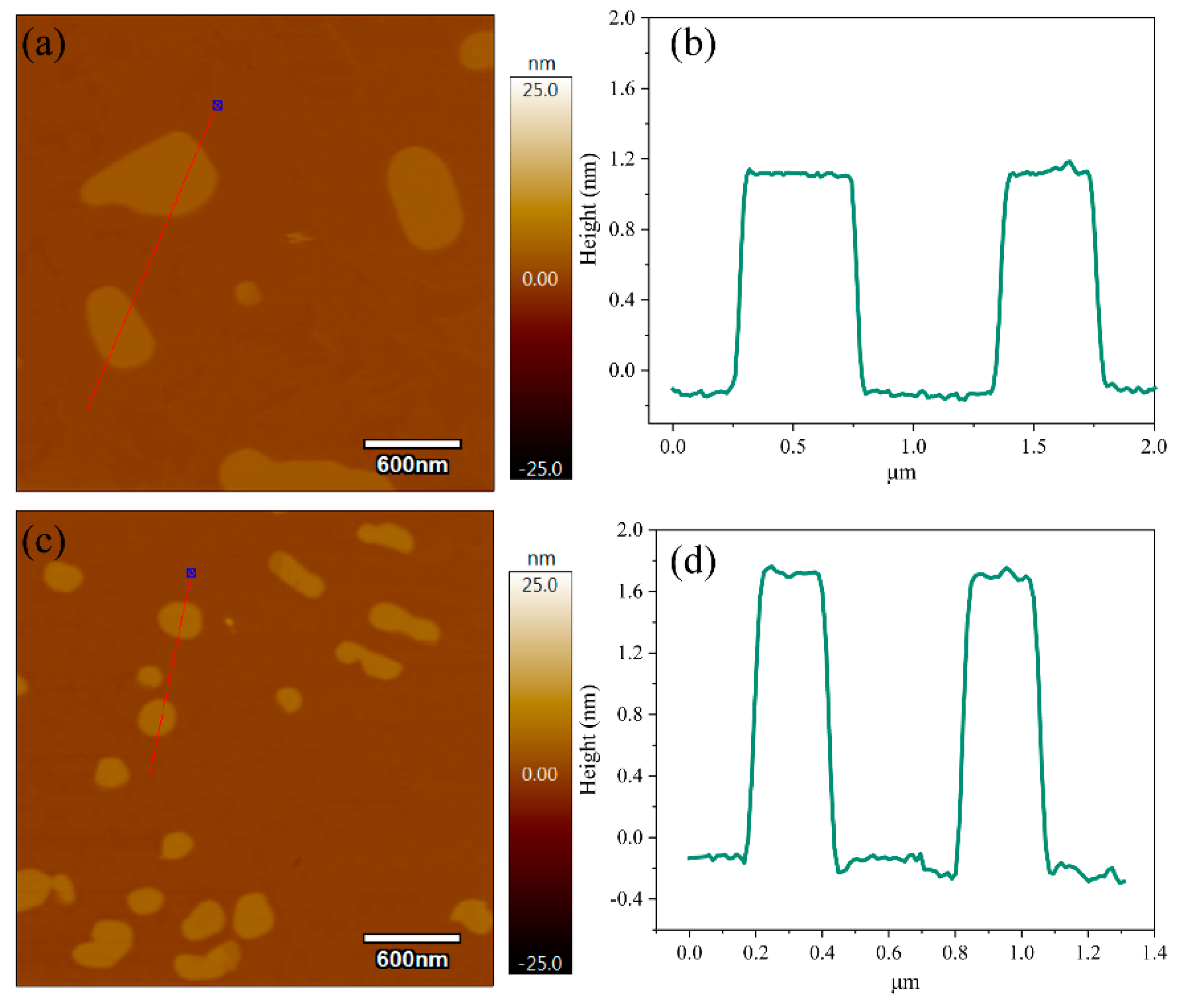
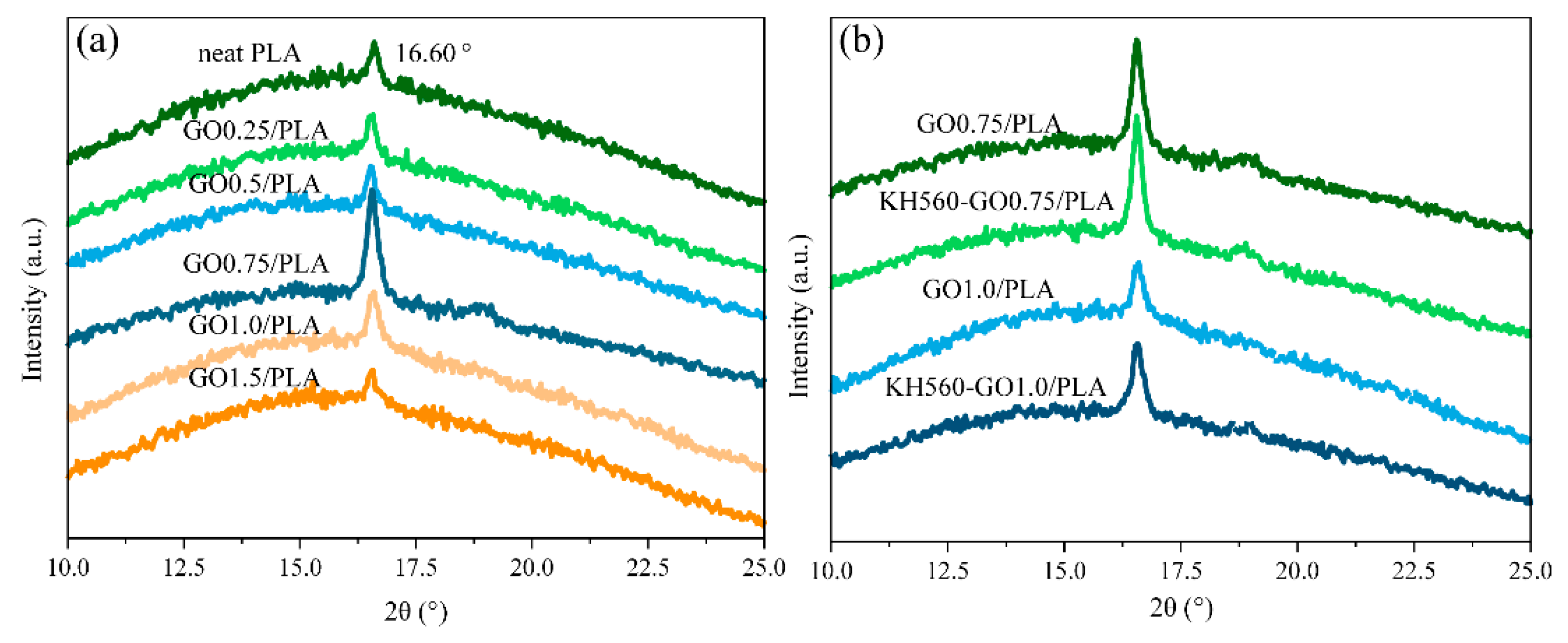
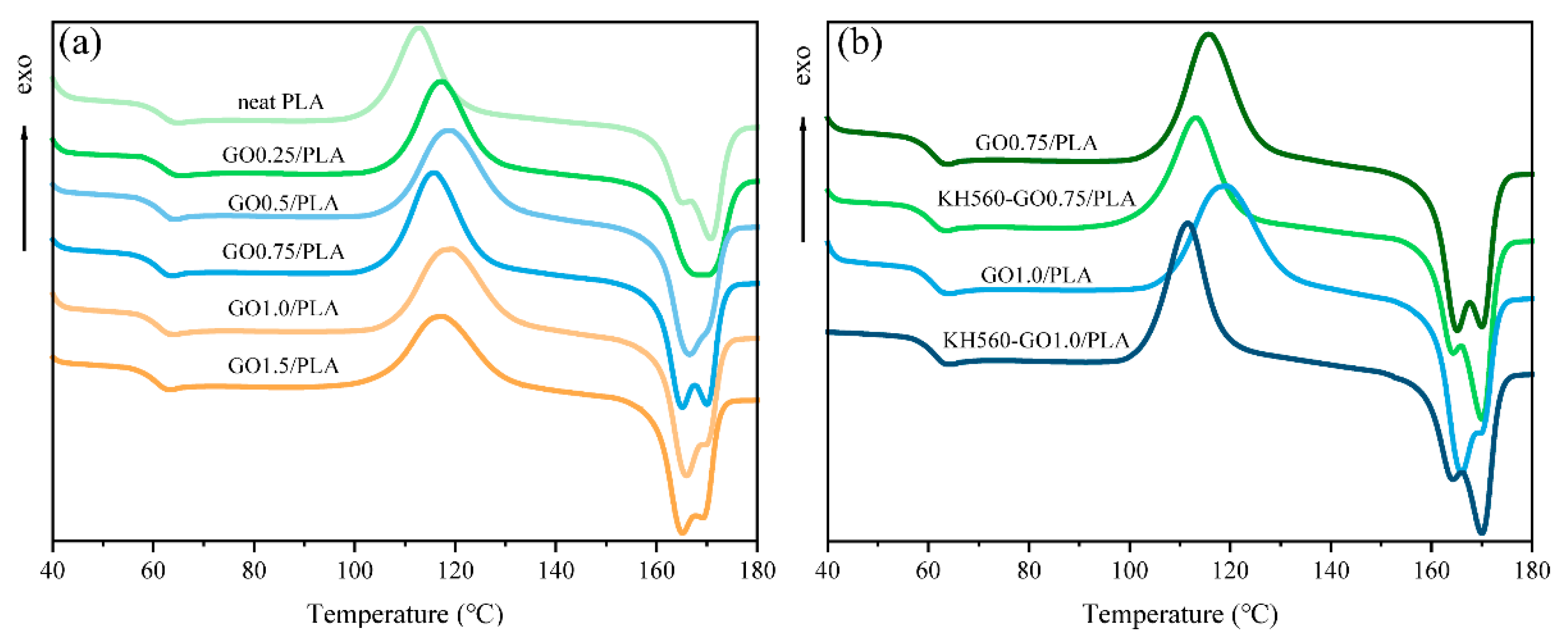
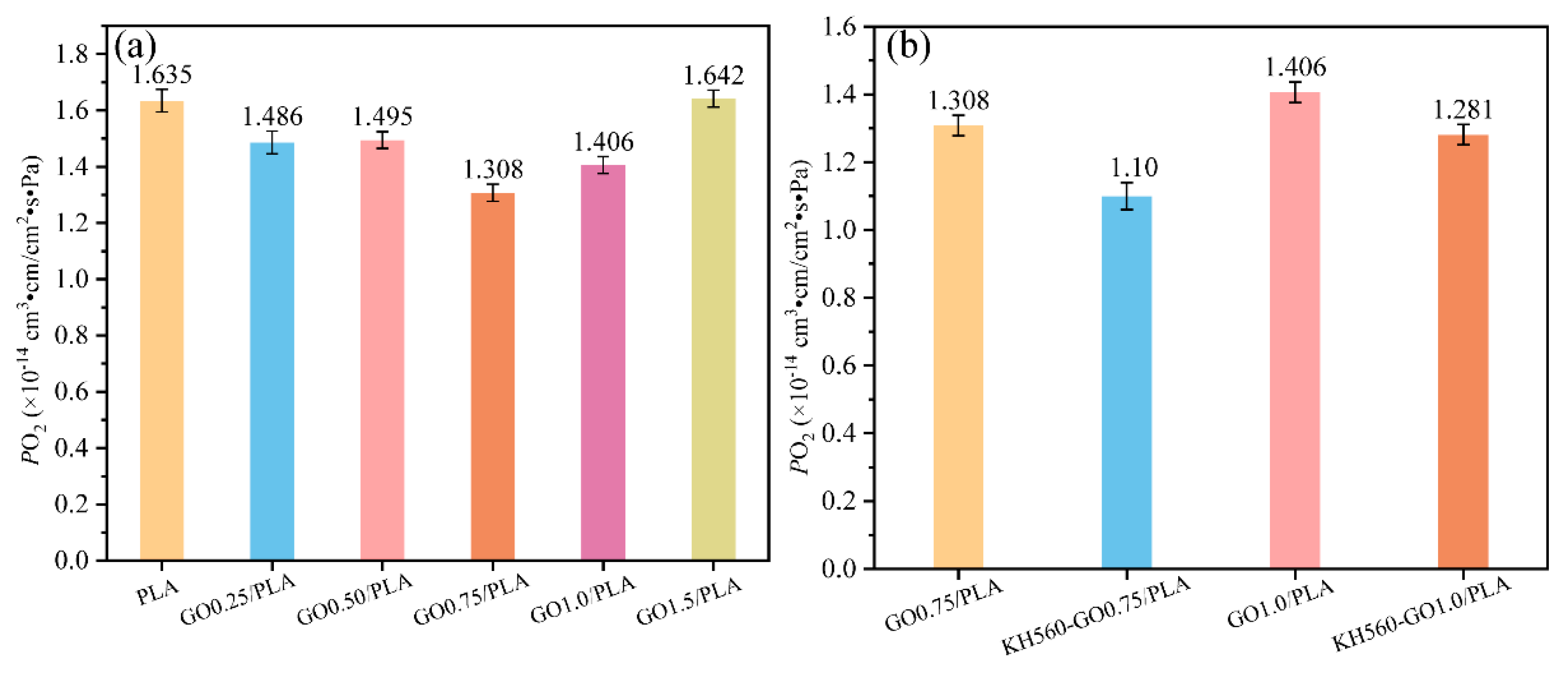
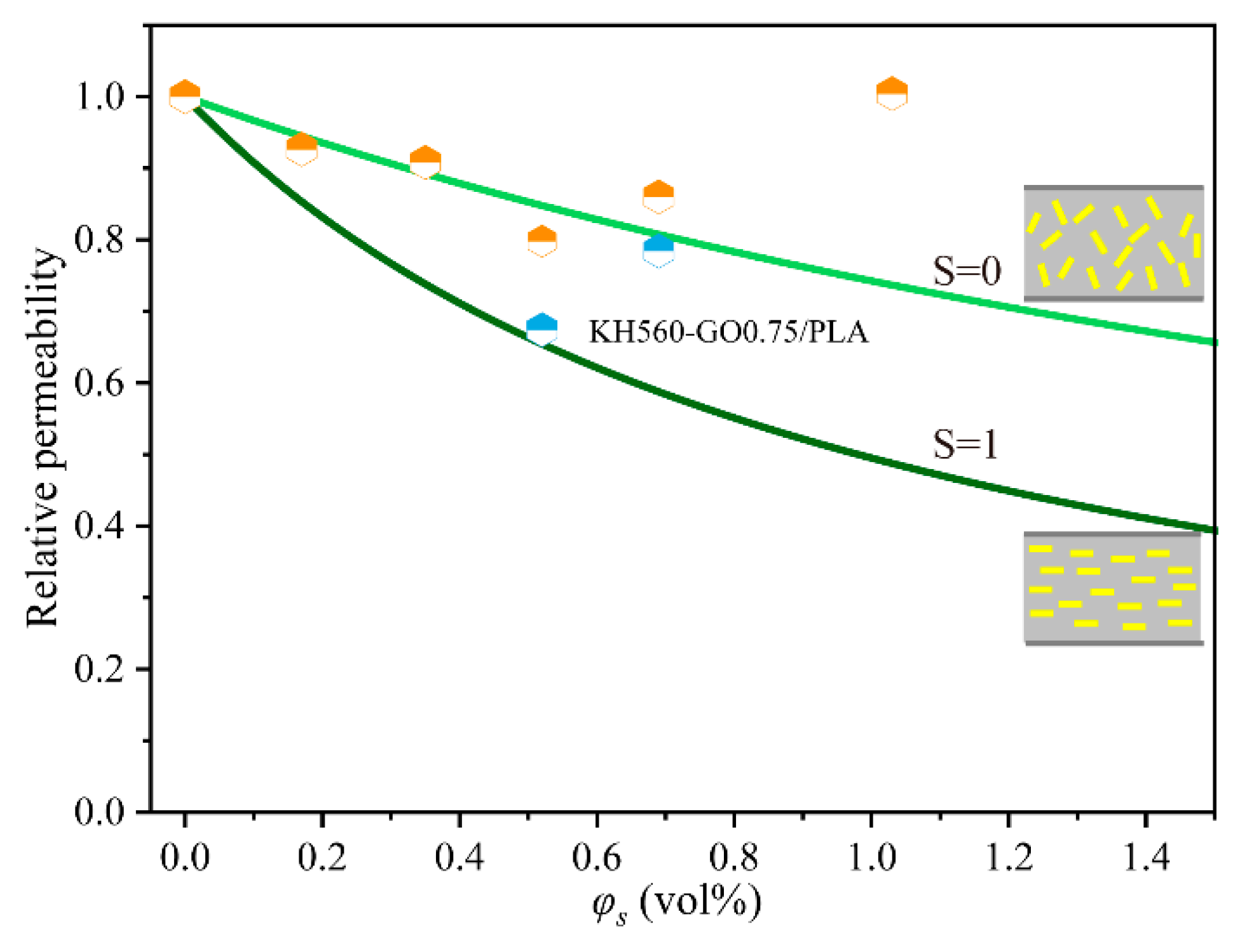

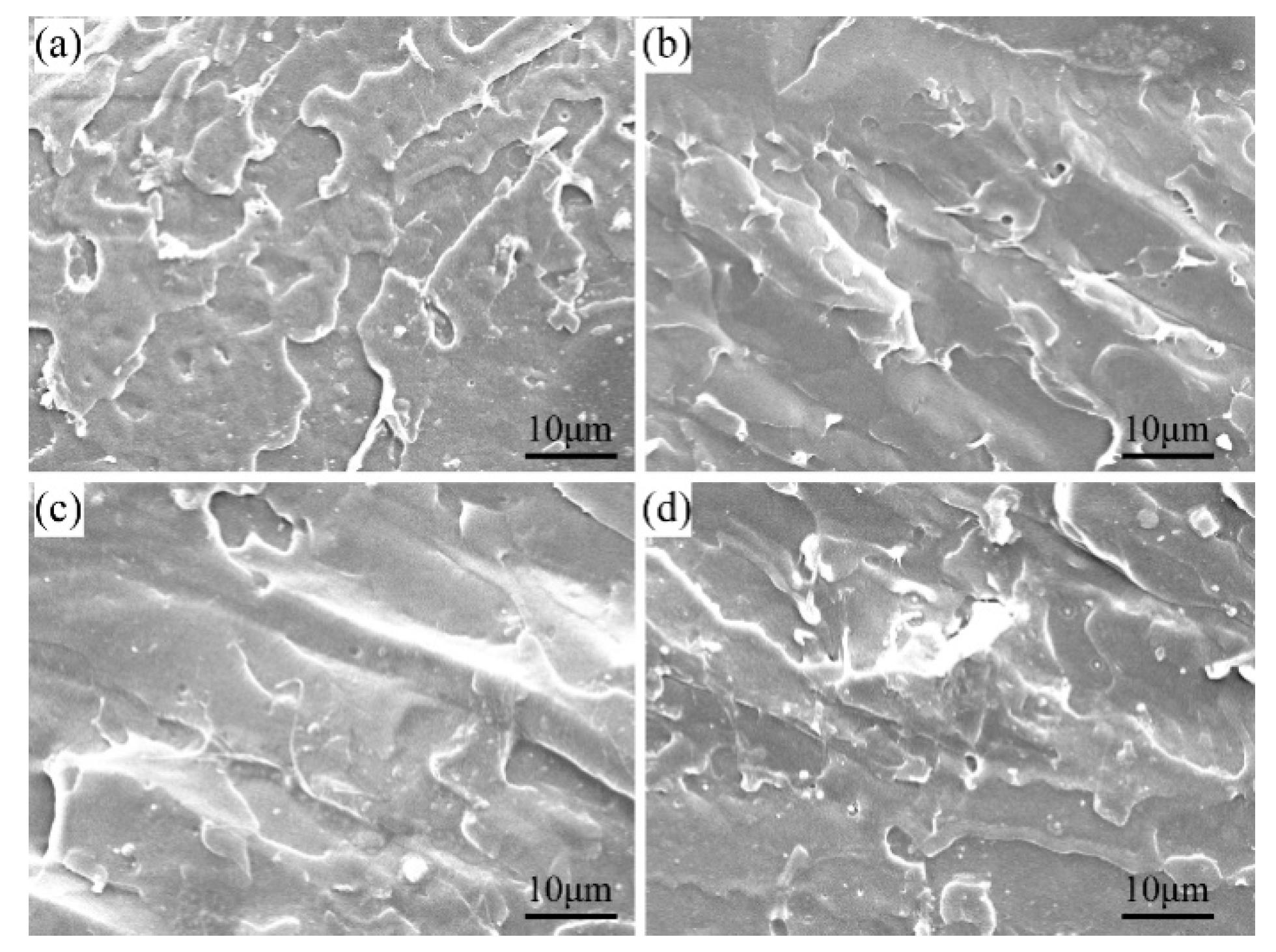
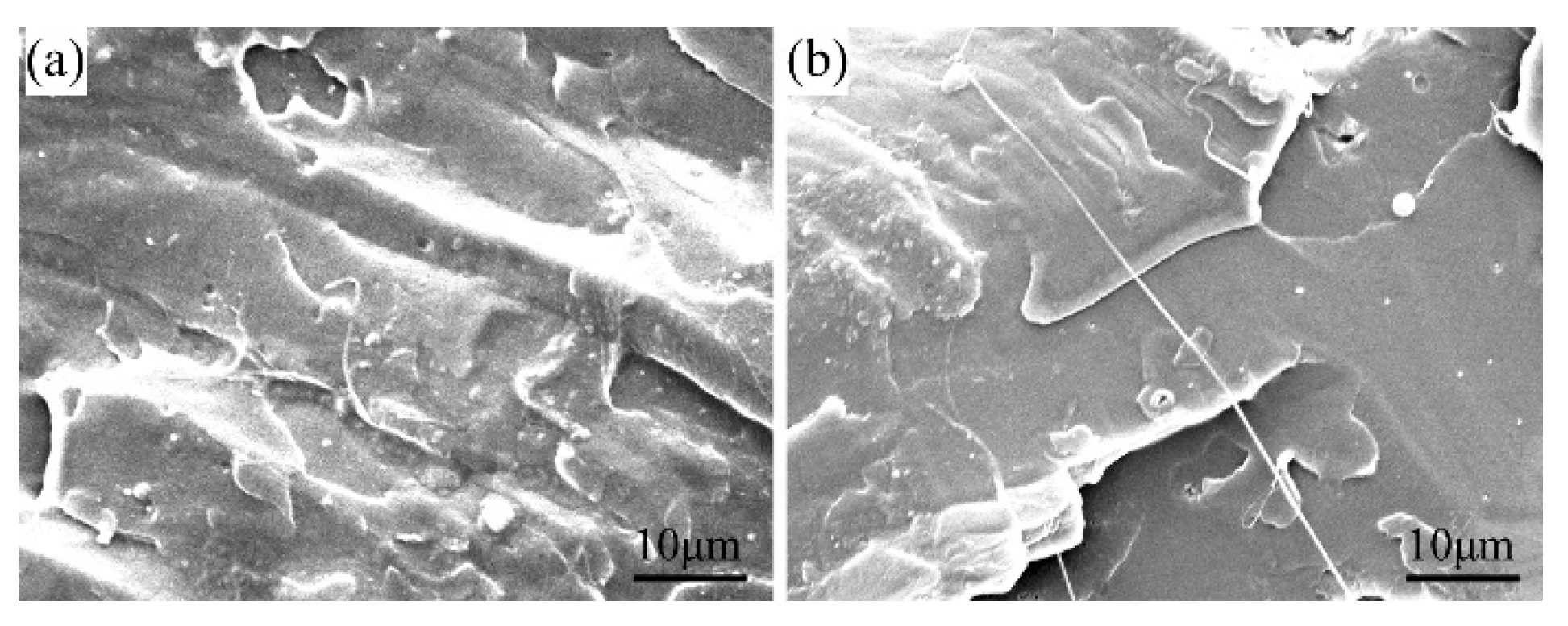
| Tg (°C) | Tcc (°C) | ΔHcc (J/g) | Tm1 (°C) | Tm2 (°C) | ΔHm (J/g) | χc | |
|---|---|---|---|---|---|---|---|
| neat PLA | 58.98 | 113.75 | 23.67 | 163.13 | 170.8 | 24.81 | 1.23 |
| GO0.25/PLA | 59.11 | 117.13 | 28.99 | 168.45 | 30.56 | 1.69 | |
| GO0.5/PLA | 58.59 | 118.80 | 31.99 | 166.59 | - | 33.91 | 2.06 |
| GO0.75/PLA | 58.20 | 115.60 | 30.61 | 166.39 | - | 32.56 | 2.09 |
| KH560-GO0.75/PLA | 57.81 | 112.10 | 25.56 | 164.33 | 170.05 | 32.53 | 7.49 |
| GO1.0/PLA | 58.37 | 119.17 | 32.47 | 165.97 | - | 34.38 | 2.05 |
| KH560-GO1.0/PLA | 58.50 | 111.47 | 27.88 | 164.27 | 170.04 | 31.39 | 3.77 |
| GO1.5/PLA | 58.02 | 117.12 | 29.35 | 165.24 | 169.34 | 31.93 | 2.77 |
| Samples | GO Loading | Preparation Method | Permeability | Reduction | ||
|---|---|---|---|---|---|---|
| wt % | vol % | Barrer * | 10−14 cm3 cm/cm2 s Pa | |||
| PLA | / | / | Melt | 0.218 | 1.635 | / |
| GO0.25/PLA | 0.25 | 0.17 | Melt | 0.202 | 1.486 | 9 |
| GO0.5/PLA | 0.50 | 0.35 | Melt | 0.198 | 1.495 | 9 |
| GO0.75/PLA | 0.75 | 0.52 | Melt | 0.174 | 1.308 | 20 |
| KH560-GO0.75/PLA | 0.75 | 0.52 | Melt | 0.147 | 1.100 | 33 |
| GO1.0/PLA | 1.0 | 0.69 | Melt | 0.187 | 1.406 | 14 |
| KH560-GO1.0/PLA | 1.0 | 0.69 | Melt | 0.171 | 1.281 | 22 |
| GO1.5/PLA | 1.5 | 1.03 | Melt | 0.219 | 1.642 | 0 |
| PLA [18] | - | solution | 0.501 | 3.76 | - | |
| 0.2 | solution | 0.179 | 1.34 | 64 | ||
| 0.4 | solution | 0.164 | 1.23 | 67 | ||
| 0.6 | solution | 0.199 | 1.49 | 60 | ||
| PLA [14] | - | solution | 0.278 | 2.087 | - | |
| 0.25 | solution | 0.206 | 1.545 | 26 | ||
| 0.5 | solution | 0.184 | 1.381 | 34 | ||
| 1.0 | solution | 0.180 | 1.348 | 35 | ||
| 2.0 | solution | 0.153 | 1.145 | 45 | ||
© 2020 by the authors. Licensee MDPI, Basel, Switzerland. This article is an open access article distributed under the terms and conditions of the Creative Commons Attribution (CC BY) license (http://creativecommons.org/licenses/by/4.0/).
Share and Cite
Li, F.; Zhang, C.; Weng, Y.; Diao, X.; Zhou, Y.; Song, X. Enhancement of Gas Barrier Properties of Graphene Oxide/Poly (Lactic Acid) Films Using a Solvent-free Method. Materials 2020, 13, 3024. https://doi.org/10.3390/ma13133024
Li F, Zhang C, Weng Y, Diao X, Zhou Y, Song X. Enhancement of Gas Barrier Properties of Graphene Oxide/Poly (Lactic Acid) Films Using a Solvent-free Method. Materials. 2020; 13(13):3024. https://doi.org/10.3390/ma13133024
Chicago/Turabian StyleLi, Fenfen, Caili Zhang, Yunxuan Weng, Xiaoqian Diao, Yingxin Zhou, and Xinyu Song. 2020. "Enhancement of Gas Barrier Properties of Graphene Oxide/Poly (Lactic Acid) Films Using a Solvent-free Method" Materials 13, no. 13: 3024. https://doi.org/10.3390/ma13133024





